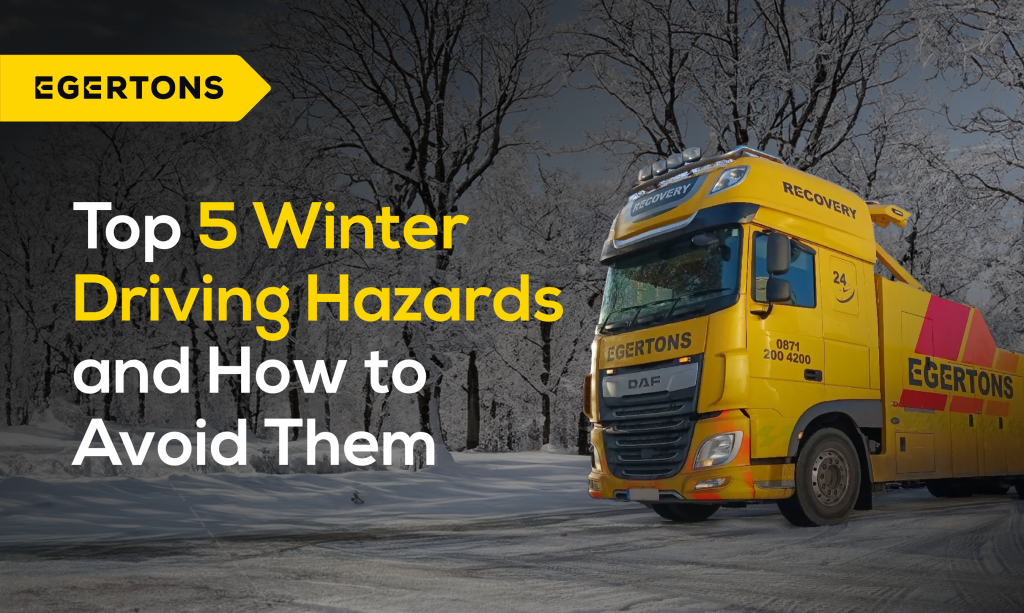In the UK, unpredictable winter weather can make roads treacherous, creating hazardous conditions for fleet operators and their drivers. However, having a clear and cautious understanding of the top winter driving hazards and how to avoid them can be crucial for ensuring fleet safety.
According to the Department for Transport (DfT), road accidents increase by 20% during the winter months, with ice, snow and fog being the most significant contributing factors, meaning that for fleet operators, preparing for these seasonal changes isn’t just a best practice, it’s a necessity.
Below, we explore the top five winter driving hazards and offer practical advice for fleet managers on how to mitigate risks. Starting with…
1. Ice and snow-covered roads
Icy roads are one of the biggest dangers drivers face in winter, and according to DfT data, nearly 1,200 accidents were caused by icy roads in the UK in 2022, often taking place in the early morning and late evening when temperatures drop.
Likewise, while less common in certain parts of the country, snow can compound the risk, making roads slippery, difficult to navigate and sometimes even blocking routes completely.
How to avoid this winter driving risk:
- Ensuring fleet vehicles are equipped with winter tyres is key, as these tyres have better traction on icy surfaces compared to standard ones, reducing stopping distance
- Using weather forecasting tools integrated into telematics systems can enable fleet managers to reroute vehicles away from hazardous areas or delay journeys if necessary
- And making sure drivers understand the importance of reducing speed and increasing the braking distance on icy or snowy roads by reinforcing winter-specific training can significantly reduce the risk of accidents
2. Reduced visibility from fog and darkness
Fog can drastically reduce visibility, particularly in rural areas or near bodies of water, and DfT data states it was a frequent cause of accidents in 2023, where fog contributed to over 400 road traffic accidents in the UK.
Combined with the longer hours of darkness, fog can also make it difficult for drivers to spot hazards or judge distances, so much so that The Highway Code advises drivers to slow down in fog and use fog lights when necessary.
How to avoid this winter driving risk:
- Making sure fleet vehicles have fully operational headlights, fog lights and rear lights is essential, and conducting regular checks, particularly after long journeys in poor weather, should become a winter time best practice
- Utilising driver-assist features such as lane-keeping assist and automatic emergency braking can be lifesavers in low-visibility conditions
- Driving in the dark is more tiring, and as tired drivers are more prone to making mistakes, it’s important to ensure all drivers are taking appropriate breaks to stay alert
3. Vehicle breakdowns
Winter weather takes a toll on fleet vehicles, particularly as cold temperatures can cause batteries to die, fuel lines to freeze and tyres to lose pressure. In fact, comparethemarket reports a 20% increase in breakdown callouts during the winter months, largely due to these weather-related issues.
For fleet operators, the costs associated with breakdowns can quickly escalate, not to mention the loss of productivity, and so taking the care to prevent any issues can make a huge difference.
How to avoid this winter driving risk:
- Scheduling pre-winter vehicle inspections such as checking batteries, tyres, antifreeze levels and heating systems can be a highly effective preventative maintenance tactic to ensure everything is in optimal working order
- Using vehicle telematics systems that can alert drivers to potential mechanical issues before they result in a breakdown, such as by monitoring battery health and tyre pressure, allows fleet managers to stay ahead of the problem
- And by ensuring all fleet vehicles carry winter emergency kits including jump leads, de-icer and thermal blankets in case of breakdowns in remote areas can be essential to protecting drivers’ safety.
4. Flooded roads
According to the Environment Agency, two-thirds of flood-related deaths in the UK occur in vehicles, making this a significant concern for fleet operators where the UK often experiences heavy rainfall during winter, which can lead to flooded roads.
In truth, even a small amount of water can render a vehicle inoperable, and driving through floodwater can be so dangerous that it can result in vehicle damage, particularly to the engine and electrical systems.
How to avoid this winter driving risk:
- Utilising telematics and GPS systems that provide real-time traffic and weather updates to avoid flooded areas can encourage drivers to follow the safest route, even if it adds time to the journey
- Ensuring drivers know never to attempt driving through floodwaters deeper than 6 inches, as this can cause hydroplaning or engine damage, is so important
Making sure the entire fleet is covered for weather-related damage via comprehensive insurance can provide peace of mind in case vehicles are caught in unexpected flooding
5. Black ice
Black ice is particularly treacherous because it’s nearly invisible, forming a thin, clear layer over the road that makes it easy to lose control of the vehicle.
It’s most commonly found on bridges, overpasses and shaded areas of the road, especially in the early morning and late evening, meaning it’s a common encounter for fleet drivers who often drive at these times and across so many different routes.
How to avoid this winter driving risk:
- Training fleet drivers to recognise areas where black ice is likely to form, such as slowing down and avoiding sudden movements like sharp steering or hard braking, can help reduce the risk of accidents
- For fleets operating in a depot, it might be possible to work with local councils or private contractors to ensure key areas are gritted during winter months
- And using predictive analytics within telematics system to identify areas where previous incidents with black ice have occurred, can help inform route planning to avoid high-risk roads
Through snow, fog or ice, we’ll be there when you need us.
Egertons is one of the UK’s leading vehicle rescue and recovery operators. We’re a dynamic organisation at the forefront of change within the recovery industry, and we’re proud of our 55-year vehicle recovery heritage.
But, what truly sets us apart is our 300-strong fleet, vast range of equipment and the technology it is equipped with. This is supported by our 24-hour control room, and having invested in industry leading software, we can seamlessly track the progress of all our vehicles and allocate jobs straight to the recovery technicians.
We’re here to make your job easier; whatever you need, whenever you need it.


